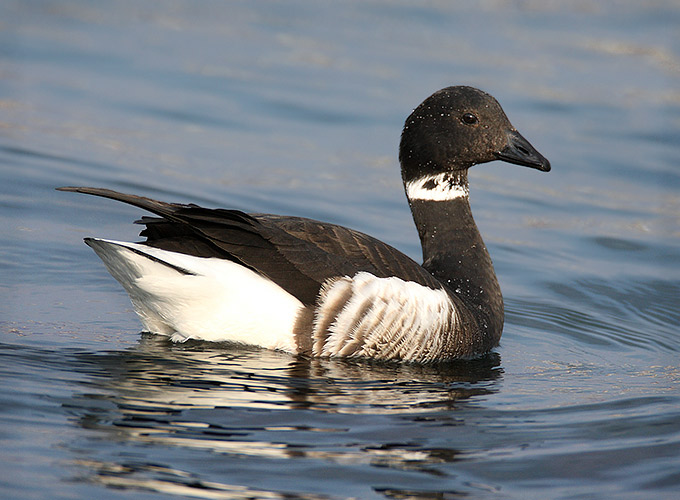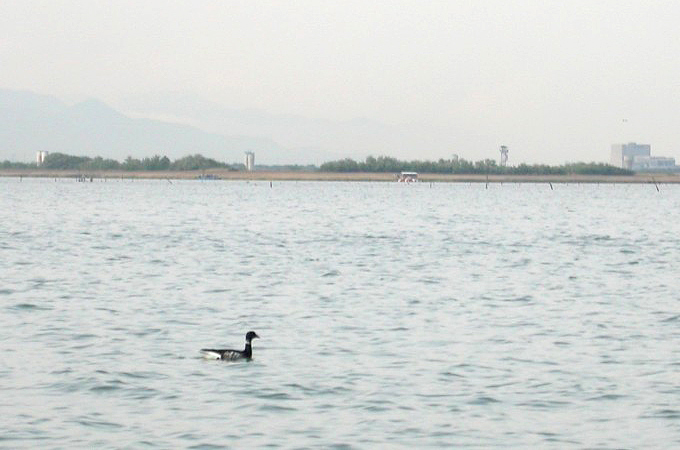
The Ramsar Convention COP 11 is coming up in July – time for Wetlands International (WI) to finish off the latest edition of the Waterbird Population estimates (Edition Five). Like earlier editions, this resource (to be launched at the Ramsar COP) will cover all of the world’s Flyways and waterbirds. For each waterbird population (1,816 listed in the Fourth Edition!), it will provide estimates or an estimate range; a 1% figure for use in Ramsar site-designations; and a general description of distribution. Based on best knowledge and incorporating thousands of references and invited comments, it will be THE baseline with which to measure a site’s international importance for waterbirds and to flag conservation priorities. And this time, it will be posted online as an interactive resource – excellent!
It is all too-easy to underestimate how much time, effort and knowledge goes into developing such work. As part of Birds Korea’s genuinely modest contribution (and also as part of behind-the-scenes research on our next fully annotated checklist), several days have already been invested in providing information from Korea to this next edition. This has been time enough only to comment usefully on a few duck species (including flagging the plunge in population of Mallard Anas platyrhynchos) and on three geese: Greater White-fronted Anser albifrons, Lesser White-fronted Anser erythropus and Brant Branta bernicla nigricans.
One simple question asked by WI was whether or not Brant in Asia are from a single Japan/Korea/China population. Trying to answer this provides a great example of why this kind of work is so time-consuming and challenging (though made easier by some excellent online resources including the Google Maps Distance Calculator at: http://www.daftlogic.com/projects-google-maps-distance-calculator.htm).
Brant is a rare winter visitor to the ROK – with only one recorded nationwide in the 2011 winter census (MOE 2011). It therefore seems to be a species on which little time needs to be spent by Korean organisations… However, it used to be less rare here. It was described by Austin (1948) as probably an “uncommon winter visitor” rather than a rarity. A read of Park (2002) reveals that a flock of 138 Brant were found in the far southwest in 1974, and that 700 were seen in early 1984 at one site in the southeast. This led to an estimate of 1,000 or so on the ROK south coast at that time. Even as recently as 2001, 393 were recorded nationwide by the winter census (MOE 1999-2004). The Brant is therefore a species that is now being found much less often and in smaller numbers in the ROK – despite the large increase in the number of birdwatchers and the greatly improved access to the coastal zone during the past 10-20 years. It is easy to conclude, therefore, that the Brant is decreasing in the ROK. It is reasonable to suggest too that tidal-flat reclamation and especially industrialisation of much of Gwangyang Bay and the outer Nakdong Estuary (the two sites that until recently supported the largest numbers of Brant in the ROK) will have contributed to this species’ worsening national conservation status.

However, even as the Brant has dwindled towards national extinction in the ROK, it has increased in Japan. According to Brazil (1991), Brant was formerly “a common winter visitor from southwest Hokkaido to as far south as Tokyo Bay” – at least until the mid-late 1800’s, when changes in gun-laws saw its demise. The Brant then remained “exceedingly scarce” in Japan, until a recovery started in the 1970s and 1980s. By 1982, three sites in Hokkaido and northern Honshu supported more than 100; and in October 1986 and 1987 no less than 5,000 were recorded in eastern Hokkaido.
Based on this, the Waterbird Population Estimates published in 2006 (Wetlands International 2006) stated that the East Asian non-breeding population of Brant was 5,000; that its breeding range was “E Siberia, Anadyr Basin eastward”; and that the wintering or core non-breeding area was “Coastal Kamchatka, Korea, Japan”. Although not included in the formal notes, the belief seemed to be that Brant staged in Hokkaido in October and November, and then migrated on to Korea (and China?) for the mid-winter. This belief was fuelled by smaller numbers being found in the mid-winter than in October/November in Japan; mid-winter census counts in the ROK; and a mid-winter record of 1,200 at the Chang Shan Islands, Shandong Peninsula in 1993.
For the Fifth edition, the Asian Brant estimate is likely to be increased further – to a maximum of >8,000, based entirely on counts in the late 2000s in Japan. And yet, despite the increase in population in Japan, the Brant is declining in Korea. And there is perhaps no evidence either of large flocks still wintering in China (if you have information to the contrary, please do mail us!).
Indeed, has there ever been any decent evidence of a migration route or link between Korean and Japanese Brant? Such evidence might include:
A mirroring of decrease and/or increase in Korean and Japanese and Chinese Brant;
Records of flocks in intermediate sites (e.g. in south-western Japan);
Migration dates showing later arrival in winter and earlier departure in spring in Korea than shown by birds in Hokkaido (which presumably are much closer to northern breeding areas).
The present “goose search” through the scant literature fails to find any such evidence. Rather, it points to a very different conclusion.
As described above, there were more Brant found in the ROK than in Japan in the 1970s (even though survey effort was much higher in the latter nation); numbers found in the ROK peaked in the early-mid 1980s (when access to the coastal zone started to become easier), and then they soon declined to now tiny numbers. In contrast, Brant increased in the 1970s through to the mid-1980s in Japan, and that increase has continued to the present. Numbers of Brant in Japan are now eight times higher than the highest estimate in the ROK back in 1984. If these birds are part of the same population, then why are larger numbers not now being found during migration, either in the ROK, in the DPRK (where according to Tomek [1999] the largest flock recorded to data was only 14, in December 1988 at Wonsan); in south-western Japan (where the Brant remains rare); or in China?
How about migration timing? Much fuller original data sets will exist. However, based on Brazil (1991), in 1985-1986 the latest Brant remained in eastern Hokkaido until April 13th. According to Park (2002), the 1974 Brant flock in the far southwest (c. 2000km WSW of Hokkaido) peaked at 138 on March 7th-8th, before falling to 111 on March 25th-26th. It is not known when the last birds were recorded. There is also a further record of 86 Brant in the ROK as late as May 3rd 2001 in the southeast. It seems unlikely that such Brant would migrate 1,600km from SE Korea to Hokkaido (three weeks after the vast majority have already departed there), and then a further 3,200km to easternmost Anadyr breeding grounds (a total distance of 4,800km) – especially when it is only 4,000- 4,200 km for the same birds to migrate directly or via the Okhotsk Sea toward breeding grounds mapped in Syroechkovskiy (2006). It seems even more implausible that Chinese Brant from Shandong and Liaoning (a location given for the species in Cheng 1987) would also choose to migrate 5,200km via Korea-Hokkaido-Anadyr, when they could reach the same Yakutian breeding grounds in only 3,750km.
Syroechkovskiy (2006) (pages 649-662 in the mammoth volume Waterbirds around the World, edited by Gerard Boere, Colin Galbraith and David Stroud) describes research on long-term declines in Arctic goose populations in eastern Asia. In Figure 9 (on page 659), he depicts both the changes in the distribution of three Brant populations and their presumed/proven migration routes. In the second half of the twentieth century, especially since the 1970s, the population of nominate Brant has moved east, and the population of far eastern nigricans (originating from North America) has moved west. There has been an increase in North American nigricans, and there has been a “drastic population decline” in Asian Brant. Now, the “Asian populations of nigricans are very small, poorly studied and close to extinction. The wintering sites in China are poorly known, and the breeding areas, which are thought to be on the lower Lena and Yana rivers (in Yakutia), have not been surveyed” (Syroechkovskiy 2006).
According to Figure 9, these Chinese (and Korean?) wintering areas are reached by one of two overland migration routes: direct from breeding areas to wintering areas; or historically, via a slightly longer route including the Okhostk Sea.
The same figure shows three additional migration routes, now used by far eastern nigricans: (1) northern Yakutia towards the Okohtsk Sea; (2) north-easternmost Russia towards North America; and (3) Anadyr north-south along the Kamchatka coast and the Kurils to eastern Hokkaido. This latter route to Japan is approximately 3,000km in length. This route’s existence has been confirmed by observations of migrating Brant along the Kamchatka coast, and apparently by some marked birds, including some proven to breed in Alaska and winter in Japan.
The sensible conclusion, therefore, is that the increase in North American nigricans has resulted both in westward range extension into Far East Asia, and also the recent increase in Brant now wintering in Japan. In contrast, the decline in the Yakutian population of Brant has been mirrored by the decline in the ROK and presumably also a decline in the Chinese population.
Brant in East Asia therefore apparently do not belong to only one population. The Chinese and Korean wintering population likely breeds in Yakutia, and the Japanese wintering population likely breeds mostly in Anadyr, far to the east. Of great concern to us here in the ROK is that the increase in Brant in northern Japan will therefore probably not result in any recovery of the Brant population in the ROK.
The Yakutia population of Brant is heading towards extinction. Clearly, it is time for the ROK and China to support conservation efforts of this highly-threatened population, both in the breeding and the non-breeding grounds. Otherwise, this population will disappear – and another beautiful species will be lost to both nations.

References:
- Austin, O. L., Jr 1948. The birds of Korea. Bulletin of the Museum of Comparative Zoology, Harvard University 101: 1-301.
- Brazil, M. 1991. The Birds of Japan. Published by Helm.
- Cheng T-H. 1987. A synopsis of the avifauna of China. Beijing: Science Press, and Hamburg and Berlin: Parey.
- MOE (Ministry of Environment). 1999-2011. Annual Reports of the Winter Bird Census (in Korean).
- Park, J-Y. 2002. Current status and distribution of birds in Korea. Department of Biology, Kyung Hee University, Seoul (unpublished thesis, in Korean).
- Syroechkovskiy, Jr.E. E. 2006. Long-term declines in Arctic goose populations in eastern Asia, Pp. 649–662 in G. C. Boere, C. A. Galbraith and D. A. Stroud, eds.
- Waterbirds around the world. Edinburgh, UK: The Stationery Office. Bird Conservation International (2011) 0:1–9. © BirdLife International, 2011 doi:10.1017/S0959270911000542
- Tomek, T. 1999-2002. The birds of North Korea. Acta Zoologica Cracoviensia 42: 1-217; 45:1-235 (in English).
- Wetlands International. 2006. Waterbird Population Estimates – Fourth Edition. Wetlands International, Wageningen, The Netherlands.



